Communication and Collective Movement in Meerkats
How do meerkats use vocal signaling to maintain cohesion, coordinate and make decisions while on the move?
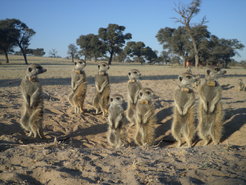
Coming to an agreement
Do you ever struggle to find an agreement when looking for a place to eat with friends? People want to stay together in order to not become isolated, while at the same time individual choices regarding the place to go likely differ based on differences in information, level of hunger, personal preferences, and other factors.
The same conundrum exists for social animal groups, with the slight twist that failing to locate food or being separated from others is literally a matter of life and death. Successfully solving conflicts of interest and reaching a consensus regarding direction and duration of travel is thus critical in the wild.
Communication is key
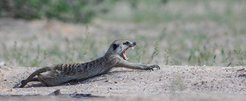
The key to successful group decision-making often lies in efficient sharing of information between party members. This can be mainly visual, with studies showing that complex group-level patterns of movement, seen in large flocks of birds or schools of fish, could emerge if each animal simply aligned its direction with its closest neighbor while maintaining appropriate inter-individual distance. But many social species, humans included, also rely on active acoustic communication. Certain species have developed large vocal repertoires of movement-related calls in order to efficiently exchange information and make decisions while on the move. Understanding the interplay between communication and movement in such complex systems is no easy task, and a lot remains unclear. This has led me to the question: What are the precise mechanisms by which movement consensus is reached in social animal groups with rich vocal exchanges? Answering this question requires knowledge of how all members of a social group are moving and vocalizing at all times. This information will allow me to analyze the interactions of vocalizations and movement at individual and group levels.
Concerning meerkats
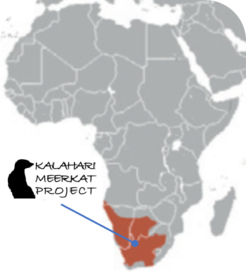
I am focusing on the meerkat, a highly-social, very-vocal mammal which lives in the arid part of southern Africa. Meerkats live in groups of up to 50 individuals, spending their day together in search of food. While each individual forages independently, the group, as a whole, manages to remain highly cohesive, alternating phases of low average speed and polarization with phases of fast, highly directed movement. Coordination during movement is greatly facilitated by the use of active vocal communication. More than 25 years of study at the Kalahari Meerkat Project in South Africa have shown that meerkats have one of the largest known vocal repertoires among non-primate mammals. They are thus a very interesting model to study the interaction between vocal communication and collective movement in the wild.
Click on the pictures to hear some examples of meerkat calls:
Alarm calls: used to warn the group of an incoming predator. Depending on the type of predator (aerial vs. terrestrial) and the level of urgency, the call structure and the group response will vary. Contact calls: used at regular intervals while meerkats are foraging. Their primary function is to allow each group member to acoustically keep track of others' locations while the group is digging for food, but there might be other functions linked to group movement and inter-individual distancing. Move calls: used to try and initiate departure from the current location of the group. Usually the group will leave if enough individuals join the call chorus (= chorum mechanisms). Lead calls: similar to move calls, used to incentivize the group to keep moving (for instance when going to the sleeping burrow). Short notes: versatile calls used in sequences, in a variety of different contexts (during sentinel behavior, while running, in social contexts...). Social calls: produced to mediate social interactions when several members are reunited, usually around a burrow entrance, and no threat is around.
How is influence distributed among group members?
Meerkat groups are ruled by a pair of dominant individuals who monopolize the breeding, but it is not clear whether they also lead the group in terms of movement. Different studies suggest different mechanisms along the shared/unshared spectrum of decision-making. I am using various approaches to test how influence on group movement is shared between group members. Possibly, one individual makes most of the decisions regarding movement (unshared or 'despotic' decision-making), alternatively, all individuals have their say (shared or 'democratic'), or anything in between, with influence varying across events and contexts.
How well can we predict a meerkat’s next movement based on its social surroundings?
I am using variations of Step-Selection Function frameworks, where the actual movement decision of an individual at a given time is compared to a series of alternative choices, to understand which social features (number of individuals present, overall call rate, presence of dominant individuals, past direction of travel…) are most important to determine individual’s next direction of movement, and at which spatial and temporal scales those features are most relevant.
Re-assessing the functions of contact calls
The contact call is a fairly frequent type of calls in social species, its role is most often assumed to maintain group cohesion through acoustic signaling. I am interested in evaluating other potential non-mutually exclusive functions of contact calls in meerkats: namely mediating inter-individual distances (testing the idea that contact calls might be attractive over long distances but repulsive over short-distances) and helping to assess food patch-quality at the group-level by varying call rate with foraging success at the individual level.
Tracking challenges
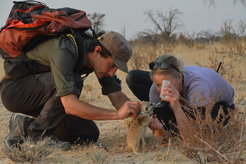
The tricky thing about studying collective movement and communication in social animals is that it requires a large amount of hard-to-obtain data. Ideally, all individuals in a given group need to be tracked simultaneously at high-resolution. This is really hard, if not impossible to get with traditional behavioral ecology approaches of visual descriptions. Within the last decade, there has been major improvement in the design and miniaturization of animal tracking devices, opening a new field of possibilities for behavioral studies in the wild. It is now possible to record many behavioral or environmental variables (movement, acceleration, temperature, pressure, etc…) on many individuals at once.
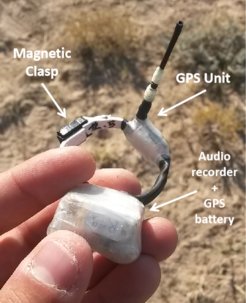
But one important problem remains, namely how to fit the tag to the animal in the first place. In many species, this would involve invasive procedures like trapping or darting, but meerkats are a truly great model system in that regard. Their level of habituation (the extent to which they tolerate the close presence of humans) can be raised to a very high degree, which is being done at the Kalahari Meerkat Project, thanks to the hard work of dedicated scientists and volunteers. Therefore, the process of collaring whole groups of wild meerkats requires only as much intrusion as giving them a bit of water.
We were able to build custom-made collars, each containing a microphone and a GPS unit, adapted to meerkats’ size and weight, and to equip every meerkat in a group with it for several days. This yielded a great amount of data about meerkats’ movements and vocalization while foraging in groups.
Past field seasons have been a success, and I am now working on data collected in 2017 and 2019 on three different meerkat groups of 7, 18 and 19 individuals, totaling 130 hours of movement and audio recording, to get insights about meerkats’ fascinating collective behavior.
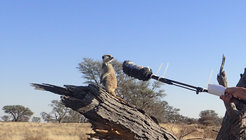
A much too often overlooked method for studying animal behavior: Asking them directly.
Further reading
Moving calls: a vocal mechanism underlying chorum decisions in cohesive groups
Vocal complexity in Meerkats and other mongoos species
Group cohesion in foraging meerkats: follow the moving ‘vocal hot spot‘


















